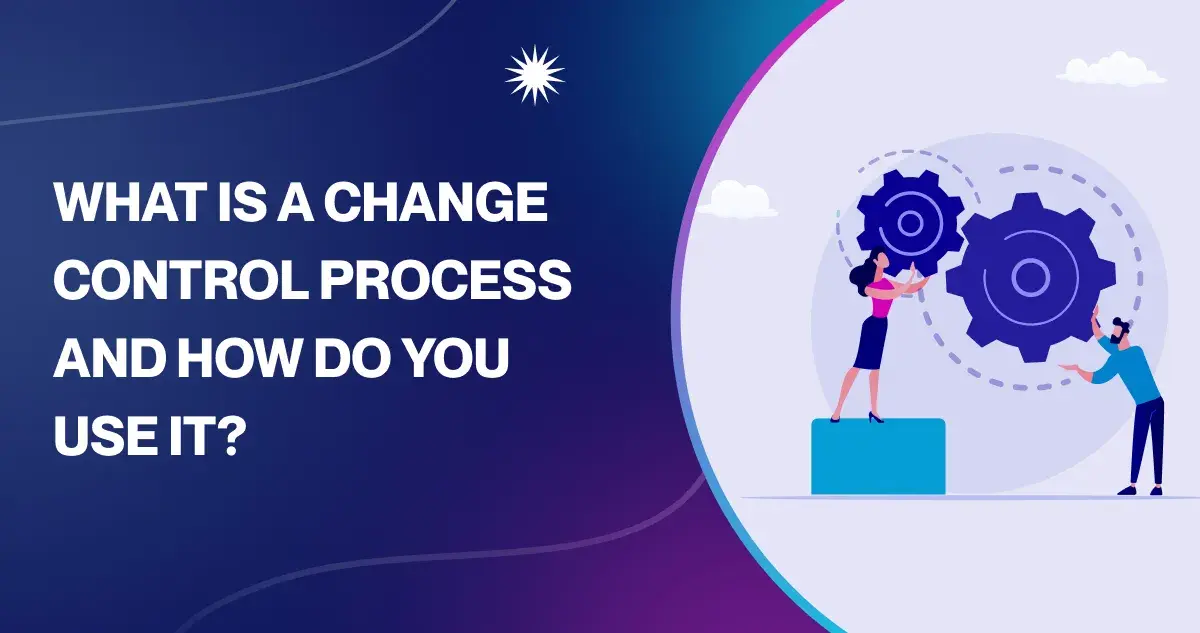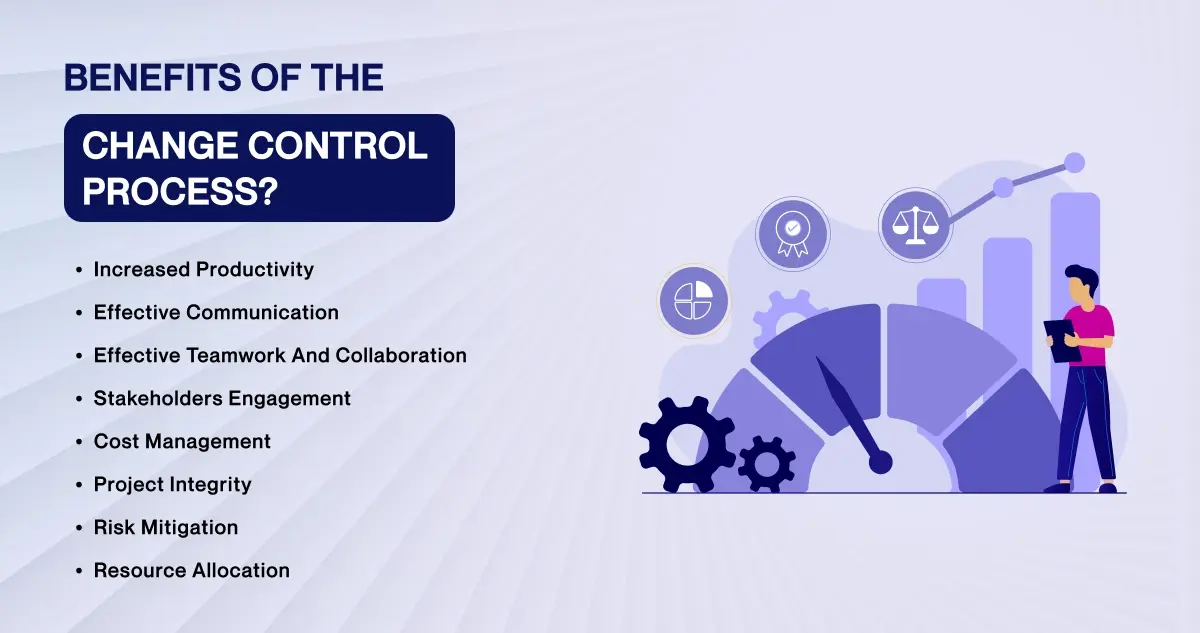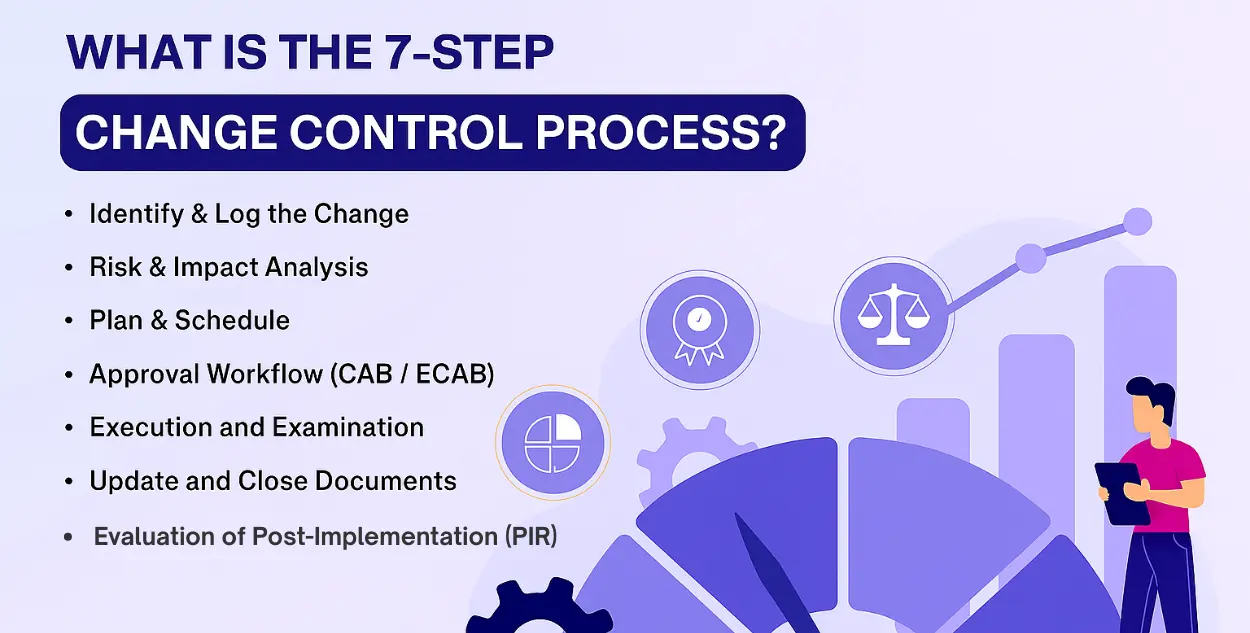
Sometimes the bigger problems are the result of small changes. These can be a new feature, an update, or a quick fix to the app. If these changes are managed incorrectly then it can lead to security issues, budget overruns, and downtime. According to Gartner, 80% of the outages are caused by changes that are not managed correctly. It shows the importance of a change control process.
We will help you understand the change control process, its tools, key components, and templates.
What is Change Control?
It is a formal methodology to request, evaluate, approve, implement, and review changes. These changes can be in business processes, softwares, or IT systems. It helps in evaluating changes for risk and impact before implementing them. It is a structured process to ensure that changes do not cause issues.
Change Control vs. Change Management vs. Release Management
These three terms seem similar but they serve different purposes in business workflow.
Change Control
It manages individual changes to software, IT systems, or hardwares. It aims to evaluate every change before it causes any risk. It works like a gatekeeper which ensures proper review of everything.
Change Management
Change management deals with how teams adapt to changes. It helps teams and people to embrace the change.
Release Management
Release management is related to scheduling, deploying, and planning changes. It ensures to implement the planned changes smoothly.
Benefits of Change Control Process in Software Project Management
The change control process offers eight main benefits in Software Project Management:

1. Increased Productivity
Change control processes help increase productivity. It helps eliminate confusion on project deliverables. The team can focus on executing the plan rather than worrying about gathering information about the changes.
2. Effective Communication
If the changes are documented properly, it helps to minimize the communication issues. A clear timeline of project goals and changes fosters better communication within the team.
3. Effective Teamwork and Collaboration
When all team members are informed of project changes, their mutual collaboration will pave the way for the successful completion of the project. Better communication further enhances teamwork and cooperation among multiple teams working on a project.
4. Stakeholders Engagement
As a company, trust in the eyes of clients is the top priority of smart team leaders and project managers. A change control process plays a major role in improving collaboration with stakeholders.
5. Cost Management
Effective control of the changes in the project prevents any unregulated or unauthorized expenditure of money. In this way, the project manager can manage the overall cost and keep the project on budget.
6. Project Integrity
In the change control process, the changes are thoroughly evaluated and assessed before making a formal implementation. This prevents any unnecessary adjustments and helps maintain project integrity by preserving the original objectives.
7. Risk Mitigation
Any project can face unforeseen circumstances. However, when there is proper documentation of changes, a project manager can save the project from any potential risks.
8. Resource Allocation
Time, budget, and workforce are essential in effective management of a project. When new changes are made to the project, it requires a reevaluation and redistribution of resources. A good change control process helps in better resource allocation.
When to use the Change Control Process?
There are many types of changes a project manager can come across during the project life cycle. These changes require us to use a change control process:
- Scope Creep: When the tasks and requirements go beyond the original project scope.
- Product Changes: when the product features or design needs to change after its release.
- Budget Adjustments: When project funding is increased or decreases.
- Timeline Modifications: When the project deadline is shortened or extended.
- Resource Constraints: When team members are unavailable or new resources are needed.
- Compliance and Regulatory Changes: When there are new laws, standards, or guidelines in the industry.
- Quality Issues: When quality standards and deliverables are adjusted.
- Client/Stakeholder Feedback: When stakeholders request changes after reviewing project milestones or deliverables.
- New Technology or Tools: When new technology and tools alter the project method.
- Market Changes: When market and trends demand changes in the project.
What are Key Components of the Change Control Process?
The effectiveness of a change control process depends on the information, systems, and personnel that drive this change. Four key elements play an important role to ensure that every change lands safely and predictably.
Change Requester
Any person who determines that a configuration item (CI) needs change is a change requester. This person can be a developer, network engineer, business analyst, or even a third-party vendor.
Advisory Board for Change (CAB)
This board consists of senior engineers, security architects, application owners, and finance representatives. The Change Advisory Board is a decision-making body which evaluates the proposed changes. It aims to analyze the changes for risk, cost, compliance needs, and possible scheduling conflicts. The board can accept, reject, or ask for additional information.
Owner/Manager of Change
The Change Manager is responsible for accountability in the entire change process. The change manager can be an ITIL-certified specialist or a senior engineer. They also perform peer reviews and post-implementation reviews to monitor the change process.
Database for Configuration Management (CMDB)
The CMDB is the primary source of truth for all configuration items and their relationships. It includes servers, virtual machines, network devices, software licenses, and API endpoints. The CMDB helps to identify all dependent applications which are impacted by change.
What is the 7-Step Change Control Process?
An effective change control process is the key for transforming any unpredictable change into win. Following are the seven steps of change control process;
Identify & Log the Change
Before taking any action, you must properly document the change. It means you must understand the nature of the change, its necessity, and the person making the request.
Risk & Impact Analysis
You must determine the possible blast radius of the change. After this, you should assign a risk level. Additionally, consult your CMDB To learn how the change might impact downstream systems or dependencies. After this, you must assign a score to the change based on two criteria. This includes the likelihood of failure and the magnitude of the business impact. Any change involving payment systems (PCI) or personal customer information (PII) should be considered as high risk.
Plan & Schedule
After identifying the risk you must clearly identify the risk. You must avoid cash with other factors such as deployments, code freezes, or significant business events. Additionally, verify the availability of all required staff during the suggested window. This includes the database administrators, network engineers, and site reliability engineers. Next, post the rollback window and estimated deployment time in a shared Change Calendar channel.
Approval Workflow (CAB / ECAB)
Every change goes through a formal approval process according to the level of risk. Standard or low-risk changes can be simply peer-reviewed or automatically approved. Every week, the Change Advisory Board (CAB) reviews both normal and high-risk changes.
An Emergency CAB (ECAB) can be formed in less than an hour in the event of urgent, business-critical changes. You must document minutes, approval requirements, and any risk acceptances.
Execution and Examination
Once approved, you can implement the change by traceable and monitored methods. To ensure traceability across the lifecycle, a distinct Change ID can be used to initiate the CI/CD pipeline. You can validate the success by using performance benchmarks, canary deployments, and automated smoke tests. If key indicators exceed the error standard then it can trigger the roll back playbook.
Evaluation of Post-Implementation (PIR)
Whether a change is successful or not, it should undergo a brief Post-Implementation Review within 24 to 48 hours. This review notes the lessons learned and closes the feedback loop. You must pay attention to whether the change meets the success criteria or if any incidents happened. It also notes whether there is a need to update runbooks or documentation.
Update and Close Documents
Formal closure is the last stage. You mark the change as "Closed – Successful," "Closed – Failed," or "Withdrawn”, depending on the result. You also add a brief summary, the date, the Change ID, the outcome, and a link to the PIR to the internal change log. A nightly automation job that checks the CMDB against the live environment and flags any configuration drift for triage the following day will help you stay proactive.
What are Tools and Software for Change Control Process?
Change management tools can help in the change control process by automating all the steps involved in change. Following are the top ten tools for change control process:
- ServiceNow
- ManageEngine
- SysAid
- Wrike
- Jira Service Management
- BMC Remedy Change Management
- Issuetrak
- SolarWinds Service Desk
- Serviceaide ChangeGear
- Spiceworks
What are the KPIs to Measure Success?
Implementing a change control process is only a half task. It is more important to measure the success of change. Therefore, it is critical to track the metrics and improve. Some of the most important KPIs to monitor include:
- Change Success Rate: It is the percentage of changes implemented without incidents or rollbacks.
- Failed Changes: It measures how often changes cause outages, degraded performance, or require rollback.
- Emergency Change Ratio: It is the number of urgent, unplanned changes as a percentage of total changes.
- MTTR (Mean Time to Recovery): It measures how quickly the team can recover from failed or disrupted changes.
Conclusion
An effective change control process is essential for maintaining project timelines, collaboration, and budget. By effectively managing change requests and involving key stakeholders, project managers can safeguard project integrity, mitigate risks, and ensure successful project completion. Incorporating change control software further enhances these efforts by automating workflows, boosting performance, and allowing project managers to focus on strategic decisions that lead to project success.
FAQS
What is the difference between a change request and a service request?
When an existing system, procedure, or configuration needs to be modified, a change request is made. In contrast, a service request usually deals with standard software installations, password resets, and access permissions, among other routine, pre-approved tasks.
What is a change control board vs. a change advisory board?
A Change Advisory Board (CAB) is the more adaptable, consultative body in the IT organizations while a Change Control Board (CCB) typically has more authority and is found in large or regulated industries.
How do you classify a change as Standard, Normal, or Emergency?
A standard change is low-risk and pre-approved. A normal change is the result of the entire review and approval process. An emergency change is high priority, unplanned, and needs to be expedited through ECAB due to the immediate risk or disruption to business.
What happens if a change is made without going through change control?
Any unauthorized or uncontrolled change can result in data breaches, system outages, compliance infractions, and finger-pointing. These changes have the potential to seriously affect business operations and erode confidence in IT procedures.




















